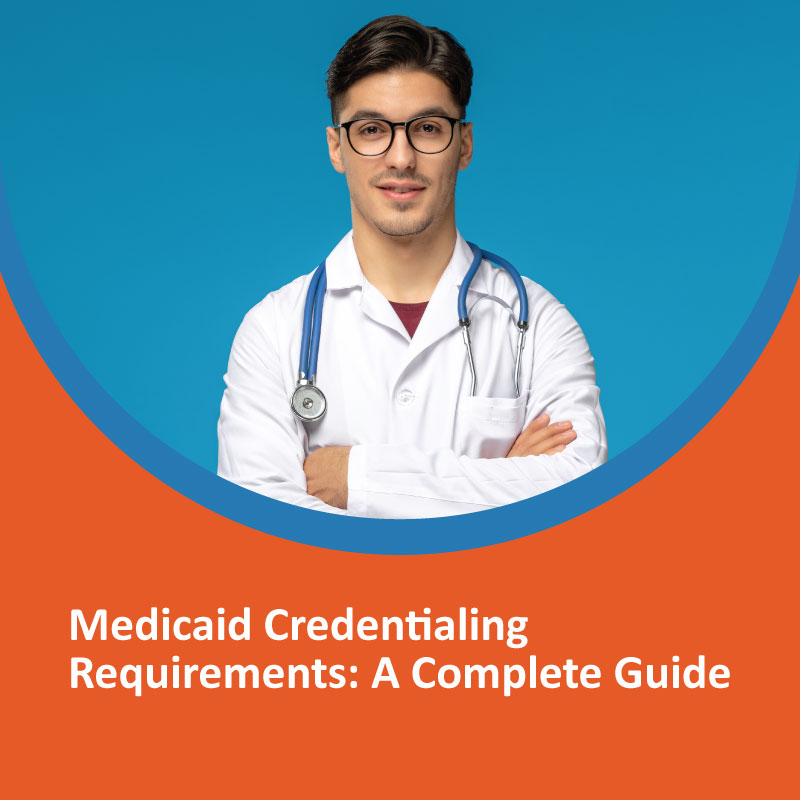If you’re a healthcare provider planning to serve Medicaid patients, Medicaid credentialing requirements are something you can’t afford to ignore. Credentialing ensures that providers meet state and federal guidelines before they can bill for services. Whether you’re a solo practitioner, part of a medical group, or managing a facility, understanding these requirements can help you avoid delays, claim denials, or even legal consequences.
In this blog, we’ll walk you through what Medicaid credentialing is, why it’s important, and the step-by-step requirements you must follow to get approved.
You may read: Credentialed Medical Assistants: A Guide to Certification and Career Growth
What is Medicaid Credentialing?
Medicaid credentialing is the process of verifying that a healthcare provider meets all necessary qualifications to offer services to Medicaid beneficiaries. This includes checking educational background, licensure, work history, malpractice history, and compliance with state-specific rules. Only once a provider is credentialed and enrolled in the Medicaid program can they legally see patients and receive reimbursement.
Why Medicaid Credentialing Matters
Credentialing isn’t just paperwork—it serves vital purposes:
- Protects patient safety by verifying provider qualifications
- Reduces fraud by ensuring only legitimate providers can bill Medicaid
- Ensures compliance with state and federal healthcare regulations
- Speeds up reimbursements by reducing claim rejections
Without completing this process, you cannot legally serve Medicaid patients or bill for your services.
Medicaid Credentialing vs. Enrollment
Although used interchangeably, credentialing and enrollment are not the same:
- Credentialing checks qualifications, licenses, and history
- Enrollment adds the provider to the Medicaid system so they can submit claims
Both steps are essential. You first get credentialed to prove your eligibility, and then enroll to become a recognized Medicaid provider.
Key Medicaid Credentialing Requirements
Credentialing requirements may vary slightly from one state to another, but the core components remain consistent across the U.S. Here’s a breakdown of the typical documents and steps required:
1. Valid State Licensure
You must hold a current, active, and unrestricted license to practice in the state where you’re applying. This applies to doctors, nurses, therapists, and any licensed healthcare professionals.
2. National Provider Identifier (NPI)
Before applying for Medicaid credentialing, you need an NPI number. This is a 10-digit identification number issued by the National Plan and Provider Enumeration System (NPPES).
3. Tax Identification Number (TIN) or Social Security Number
Providers must submit their TIN (for organizations) or SSN (for individuals) along with IRS documentation. This ensures your payments and tax filings are accurate.
4. Completed CAQH Profile (if applicable)
Many states and insurance plans use the CAQH (Council for Affordable Quality Healthcare) for provider data collection. You may need to complete or update your CAQH profile with:
- Work history
- Education details
- Malpractice coverage
- Licenses and certifications
- Practice locations
5. Malpractice Insurance
Proof of current and valid professional liability insurance is a must. This protects both you and your patients in case of legal disputes.
6. Background Checks
Most states will conduct a criminal background check. You may also be screened for:
- Medicare or Medicaid fraud history
- Felony convictions
- License suspensions
7. DEA Certification (if applicable)
If your practice involves prescribing medications, you must hold a valid DEA (Drug Enforcement Administration) registration.
8. Board Certifications (if applicable)
Some specialties require board certification in addition to your license. These certifications need to be active and up to date.
9. Signed Provider Agreements
You must sign a provider agreement that outlines the terms, responsibilities, and rules for participating in Medicaid. This document serves as a legal contract between you and the state Medicaid program.
10. Medicaid Application Forms
Finally, you must complete your state-specific Medicaid application. Each state’s Medicaid office may have slightly different forms, but they typically require:
- Provider information
- Practice address
- Tax and banking info for reimbursements
- Supporting documentation
The Credentialing Process: Step-by-Step
Here’s how the Medicaid credentialing process typically works:
- Gather documents like licenses, insurance, NPI, TIN, etc.
- Create or update your CAQH profile
- Submit your application to the appropriate state Medicaid agency
- Undergo verification and screening
- Wait for approval, which can take 60 to 120 days depending on the state
- Receive your Medicaid provider number, allowing you to start billing
Tips to Speed Up the Process
- Stay organized. Missing documents are the #1 reason for delays
- Double-check information for accuracy. Typos can cause rejection
- Respond to requests quickly if Medicaid asks for additional documentation
- Renew credentials regularly. Most states require recredentialing every 1–3 years
- Consider using a credentialing service if the process feels overwhelming
What Happens After You’re Credentialed?
Once credentialed, you’ll be added to the Medicaid provider network. From there, you can:
- Accept Medicaid patients
- Bill Medicaid for services
- Access provider portals for claims, eligibility checks, and reports
Keep in mind that failing to maintain compliance—such as an expired license or lapsed insurance—can result in removal from the Medicaid network.
Conclusion
Medicaid credentialing requirements are essential for any healthcare provider who wants to serve low-income patients and receive Medicaid reimbursements. While the process may seem lengthy or bureaucratic, staying informed and prepared will make it smoother. By meeting the requirements and maintaining compliance, you can grow your practice while helping underserved communities access quality care.
FAQs About Medicaid Credentialing Requirements
1. How long does Medicaid credentialing take?
It usually takes between 60 to 120 days, depending on the state and completeness of your application.
2. Do I need to reapply if I move to a different state?
Yes, Medicaid is state-specific. You must reapply and meet the credentialing requirements in the new state.
3. Can I start seeing Medicaid patients while waiting for approval?
No, you must wait until you’re fully credentialed and enrolled before billing Medicaid.
4. What happens if my application is denied?
You’ll receive a letter explaining the reason. You can often correct errors and reapply.
5. Is CAQH mandatory for Medicaid credentialing?
Not in every state, but many Medicaid agencies and MCOs use CAQH to collect provider data.



